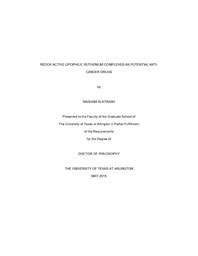| dc.description.abstract | The dinuclear ruthenium(II) polypyridyl complexes (RPCs) [(phen)2Ru(tatpp)Ru(phen)2][PF6]4 (P4+) and the monomeric [(phen)2Ru(tatpp)]Cl2 (MP2+) are promising candidates for anti-cancer drug development in terms of the observed anti-tumor activity in vivo and in vitro. These complexes contain the redox-active tatpp (9,11,20,22-tetraazatetrapyrido[3,2-a:2'3'-c:3'',2''-1:2''',3''']-pentacene) ligand which seems to be the critical component for biological activity. These complexes cleave DNA when reduced in situ to a radical species. Both complexes exhibit selective cytotoxicity toward cultured malignant cell lines and showed inhibition of tumor growth in vivo. This work expands on this platform by preparing and examining more lipophilic analogues of P4+ and MP2+. Specifically, four lipophilic ruthenium(II) polypyridyl complexes, [(Ph2phen)2Ru(tatpp)Ru(Ph2phen)2][PF6]4 (PPh4+), (Ph2phen, 4,7-diphenyl-1,10-phenanthroline), [(Me4phen)2Ru(tatpp)Ru(Me4phen)2][PF6]4 (PMe4+), (Me4phen, 3,4,7,8-tetramethyl-1,10phenanthroline), [(Me4phen)2Ru(tatpp)][PF6]2 (MPMe2+), and [(Ph2phen)2Ru(tatpp)][PF6]2 (MPPh2+), have been synthesized and characterized in which 4,7-diphenyl-1,10-phenanthroline or 3,4,7,8-tetramethyl-1,10-phenanthroline ligands were used to replace the phenanthroline ligands in P4+ and MP2+. A structure-activity examination of their partition coefficient (log P), DNA cleavage activity, cytotoxicity, and animal acute toxicity followed. Log P data revealed lipophilicity decreased in the order: MPPh2+ > PPh4+ > MPMe2+ > PMe4+ > MP2+ > P4+ as expected. We hypothesized that increasing the lipophilicity of the ruthenium complexes would increase cytotoxicity and decrease animal toxicity, yet have little effect on their DNA cleavage activity. This is because all four analogues retain the putative DNA cleaving unit (tatpp ligand) but being more lipophilic, they should more easily enter cells, increasing cytotoxicity, and on the same basis, be slower to build up in the bloodstream after IP injection in animal toxicity studies. IC50 values for all complexes were obtained for H358, CCL228, MCF-7, and against normal cell line MCF-10. The cytotoxicity of P4+, MP2+ and [Ru(phen)2dppz]2+ were also evaluated in NSCLC cell lines H358, HCC2450, H522, H1993, H2073, H322, H2122, H460 and the pancreatic cancer (PANC1) cell line using standard MTS and clonogenic assays. The lipophilic ruthenium complexes MPPh2+, PPh4+, MPMe2+, and PMe4+ showed no acute animal toxicity in a screen of the MTD in Balb/c mice with doses up to 160 mg drug/Kg mouse. Furthermore, the absorption and the distribution of drug after administration by intraperitoneal (IP) injection in male Wister Han rats were discussed. Lastly, we present the results from a NCI-60 panel prescreen of MPPh2+ complex that was submitted through the Developmental Therapeutics Program of the National Cancer Institute. In comparison with P4+ and MP2+, these analogues generally showed similar DNA cleavage activity, enhanced cytotoxic activity in cultured malignant human cells, and reduced animal toxicity in Balb/c mice. | en_US |


